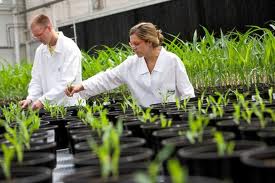Scientist, Michael Holdsworth, explaining how this break-though could move this technology forward.  Scientists working on engineering flood tolerant crops. |
Topic background Across
the globe there has been fiscal and social demand for flood-tolerant
crops. This issue was finally taken up in the late 1980's but until
recently, there had been no landmark occasions. 10 Starting in 2009, flood-tolerant rice was engineered and helped solve a huge hunger crisis in some countries. 3Then
on October 23, 2011 there was a huge breakthrough in the field. The
mechanism that causes a plant to be flood-tolerant was identified. This
later helped scientists develop a flood-tolerant wheat strain earlier
this year! 4The mechanism works like this: Flood-tolerant plants have a protein that is unstable when oxygen levels are normal. When a flood occurs, and oxygen levels are lowered this protein becomes stable. And, believe it or not this protein's new stability changes almost everything about the plant. It begins to transcribe its genes, slows it's metabolism so it requires less oxygen, and controls/regulate key proteins called "Transcription Factors" that turn genes on and off. When water levels then go back down these protein's become unstable again, creating a feedback, or "switch" if you will.13 Genomic Details: One of the researchers at UC Riverside, Julia Bailey-Serres, head of the Botany
and Plant Sciences Department said, "When a plant cell is starved for
oxygen, it cannot efficiently generate adenosine triphosphate or ATP,
the high-energy molecule plants use for energy storage, because the
plant cannot generate enough energy to sustain normal growth, it tries a
different approach: it taps into its energy reserves, resulting in more
sugars breaking down, as opposed to when oxygen is available, in order
to produce ATP. These subtle changes in metabolism are characteristic of
low oxygen stress in plant and animal cells. It's similar to the
production of lactic acid in our bodies when we exercise. We produce
lactic acid as a by-product because we are not producing energy
aerobically." This means that when flooding occurs the proteins in the
plants become stable and therefore act differently. This means they
transcribe differently, turn different genes on
and off, and most importantly slow down the plants metabolism so it
uses the minimal oxygen slower. All of this contributes to the plants
survival.15
|
|||
http://www.cnn.com/video/?/video/tech/2009/02/02/waterproof.rice.cnn ^^^CLICK THE LINK FOR MORE INFO^^^ (A type of rice that is "tougher" and more flood resistant) |
||||
